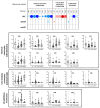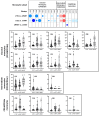Long-Term Elite Controllers of HIV-1 Infection Exhibit a Deep Perturbation of Monocyte Homeostasis
- PMID: 40362169
- PMCID: PMC12071947
- DOI: 10.3390/ijms26093926
Long-Term Elite Controllers of HIV-1 Infection Exhibit a Deep Perturbation of Monocyte Homeostasis
Abstract
Elite controllers (ECs) represent a unique subset of people living with HIV (PLWHs), who can suppress viral replication without requiring antiretroviral therapy (ART). However, despite this viral control, ECs exhibit increased incidences of various comorbid conditions and heightened systemic inflammation, which has been linked to monocyte activation. In this study, we performed an in-depth phenotypic analysis of monocytes in a cohort of long-term ECs (LTECs) and compared them to non-controller patients with ART-mediated control of HIV replication and to non-controller patients with uncontrolled viral replication. A total of 67 participants were included: 22 LTECs, 15 non-controllers on ART (onART), 10 non-controllers without ART (offART), and 20 uninfected controls (UCs) as a reference group. Monocyte phenotypes were analyzed using spectral flow cytometry with a 13-marker panel. The data were analyzed using two approaches: (a) FCS Express software v.7 to define different subsets of monocytes and assess the levels of expression of eight different monocyte functional markers and (b) R software v.4.1.1 for unsupervised multidimensional analysis, including batch correction, dimensionality reduction, and clustering analysis. Monocyte phenotypic profiling was conducted using three different approaches: (1) assessment of monocyte subsets (classical, intermediate, and non-classical monocytes); (2) evaluation of the levels of expression of eight monocyte functional markers, and (3) characterization of monocyte clusters defined through the dimensionality reduction of flow cytometry data (56 different clusters). The monocyte phenotype of the onART group closely resembled that of the UC group. In contrast, LTECs exhibited important alterations in the monocyte phenotype compared to that of the UCs, including (a) an increased proportion of intermediate monocytes and a decreased proportion of classical monocytes (p < 0.01), (b) altered expressions of functional markers across monocyte subsets (p < 0.05), and (c) alterations in sixteen different monocyte clusters (twelve decreased and four increased, p < 0.05). Many of these alterations were also observed when comparing the LTEC and onART groups. Our findings suggest that monocyte-driven mechanisms may contribute to HIV control in LTECs; however, some of these alterations could also promote systemic inflammation and immune activation. These observations provide a compelling rationale for considering therapeutic interventions in this unique population of PLWHs.
Keywords: HIV infection; clustering analysis; elite controllers; immune phenotype; monocytes.
Conflict of interest statement
Author José M Ligos was employed by the company Cytek Biosciences. The remaining authors declare that the research was conducted in the absence of any commercial or financial relationships that could be construed as a potential conflict of interest.
Figures




Similar articles
-
T Cell Homeostasis Disturbances in a Cohort of Long-Term Elite Controllers of HIV Infection.Int J Mol Sci. 2024 May 29;25(11):5937. doi: 10.3390/ijms25115937. Int J Mol Sci. 2024. PMID: 38892124 Free PMC article.
-
A specific natural killer cells phenotypic signature associated to long term elite control of HIV infection.J Med Virol. 2024 May;96(5):e29646. doi: 10.1002/jmv.29646. J Med Virol. 2024. PMID: 38699988
-
Monocyte Based Correlates of Immune Activation and Viremia in HIV-Infected Long-Term Non-Progressors.Front Immunol. 2019 Dec 6;10:2849. doi: 10.3389/fimmu.2019.02849. eCollection 2019. Front Immunol. 2019. PMID: 31867010 Free PMC article.
-
HIV controllers: hope for a functional cure.Front Immunol. 2025 Feb 25;16:1540932. doi: 10.3389/fimmu.2025.1540932. eCollection 2025. Front Immunol. 2025. PMID: 40070826 Free PMC article. Review.
-
Elite controllers: A heterogeneous group of HIV-infected patients.Virulence. 2020 Dec;11(1):889-897. doi: 10.1080/21505594.2020.1788887. Virulence. 2020. PMID: 32698654 Free PMC article. Review.
References
MeSH terms
Substances
LinkOut - more resources
Full Text Sources
Medical

